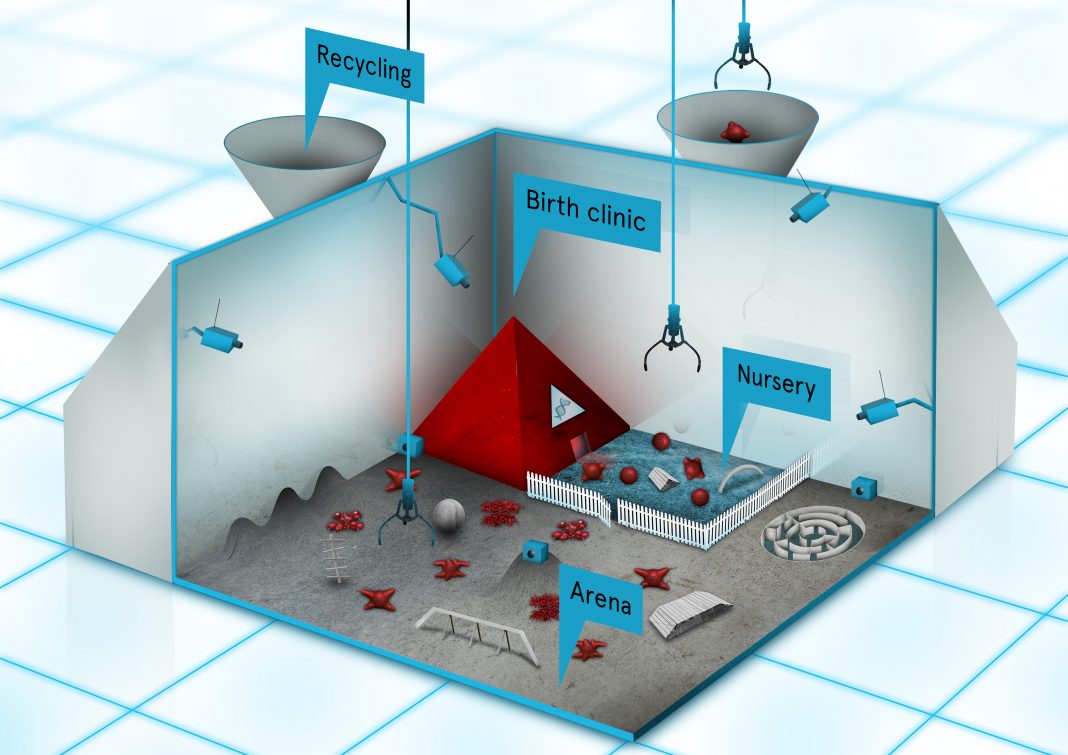The long-term vision of robot evolution foresees a radically new robotic technology where robots can reproduce, evolve, and learn
Embodied Intelligence
Building intelligent machines is a longstanding grand challenge in artificial intelligence (AI). Traditionally, in the 20th century, AI was concerned with thinking machines, e.g., for chess- playing or medical diagnosis. The focus nowadays is broader: intelligent behaviour is not limited to thinking but also includes acting. Thus, the AI challenge of the 21st century is to make intelligent machines with agency – robots for short– operating in a physical environment rather than just making calculations. The number of possible applications, operational environments, and tasks to be performed by robots is countless. However, while designing and optimizing robots is a hard task, a methodology or set of tools to conduct research and to explore the design space of bodies is still lacking.
Robot evolution and development requires significant efforts from highly trained experts which is not scalable. Thus, we need novel algorithmic approaches and research tools to explore the space of bodies and brains together and solve the design problem (good body) and the control problem (good brain). New methods are also needed to tackle complex environments without good models, not only simple, well-known conditions, e.g., factories or living rooms.
Evolution as Problem Solver
Most people think of evolution as a biological phenomenon that produced Life on Earth, plants, animals, and us, the Homo Sapiens. Within Computer Science, however, there is another view: evolution is seen as a metaphor for problem-solving, in particular, as a special approach to optimization, working with a ‘population’ of solutions and improving them over time through repeated selection-reproduction cycles. Crucially, reproduction amounts to creating new solutions by perturbing and/or recombining existing ones and selection favours the best existing solutions to proceed with (survival of the fittest). The resulting subfield within computer science is known as Evolutionary Computing. The so-called Evolutionary Algorithms have been successful in solving hard optimization and design problems and proved to have big advantages in general: 1) high-quality solutions that are hard to obtain by conventional optimization methods, 2) outside-the-box solutions that are unlikely to be conceived by human experts, and 3) the ability to adapt to changing situations.
Robot Evolution
A fruitful combination of Evolutionary Computing with robotics has resulted in the field of Evolutionary Robotics which is concerned with the evolutionary design and optimization of the overall makeup (the body) and the control (the brain) of simulated and real robots. The underlying rationale is straightforward: As natural evolution has produced successful life forms for practically all possible environmental niches on Earth, it is plausible that artificial evolution can produce specialized robots for various environments and tasks. As of today, this is a working hypothesis, to deliver a proof much research and development is needed.
Evosphere at the Vrije Universiteit Amsterdam
The Computational Intelligence Group at the Vrije Universiteit Amsterdam (VUA) is a top centre of expertise regarding robot evolution. The group is working on the algorithmic foundations and the first prototype of an evosphere, a facility where real (not simulated) robots reproduce, evolve, and learn. The concept is based on a generic model of robot evolution, named the Triangle of Life, that distinguishes three stages in a robot life cycle: (1) Morphogenesis, (2) Infancy, and (3) Mature Life. Hence, an evosphere has three components, the Production Center, (Birth clinic in Fig. 1), where new robots (phenotype) are constructed according to the specification (genotype) obtained by recombining the genotypes of two parents, the Training Center (Nursery) where ‘newborn’ robots undergo a learning process, and the Arena where mature robots operate and evolve.
Newborn babies in the nursery
In the Bio-Inspired Robotics Lab at the VUA, the Birth clinic is implemented by using 3D printers and prefabricated components (CPUs, batteries, servos, cameras) to construct ‘robot babies’ (the phenotypes) based on evolvable specifications (the genotypes). Newborn robots in the Nursery learn by iteratively generating and testing controllers to improve their performance on a set of predefined tasks. The process is driven by external computers and a system of overhead cameras that observe the robots and assess their task performance. After successfully completing the learning syllabus, robots are declared fertile adults and released in a large robot arena where they can ‘live’. Based on conditions set by the researchers, mature robots can conceive children by sending their specifications (the genotype, the robotic DNA) to the Birth clinic, where it is combined with the DNA of another robot to produce a new genotype that inherits traits from both ‘parents’.
Industrial Evolution: a new Robotic Technology
The long-term vision foresees a radically new robotic technology, where robots can reproduce, evolve, and learn, thus becoming fitter and fitter to the environment and fit for purpose without the need for direct human oversight. This will enable future applications in remote, possibly hostile environments and unforeseen conditions like deep seas, cave systems or other planets. Admittedly, this sounds like science fiction, but pioneering work done in academic labs worldwide and at the Vrije Universiteit Amsterdam is making it more and more science and less and less fiction.

This work is licensed under Creative Commons Attribution-NonCommercial-NoDerivatives 4.0 International.


